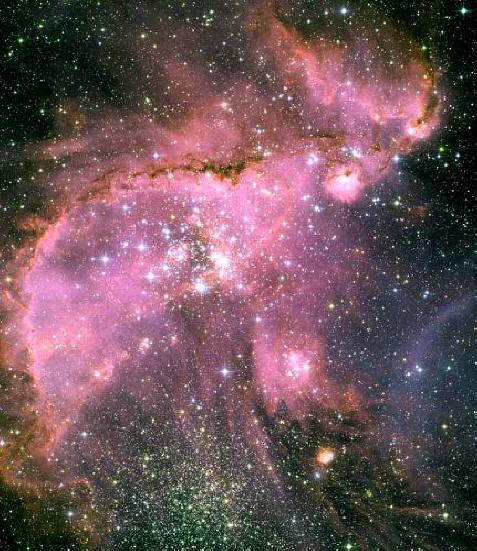|
|
Feeding Habits
May
14, 2009
The nebular hypothesis is brought
out once again to explain how stars
are born and age.In 1755 the German
philosopher Immanuel Kant proposed that the Sun and the planets
of the solar system were originally formed out of a cloud of
dust and gas floating in space. Over eons of time, the cloud
condensed because the gravitational attraction between particles
caused them to clump into larger and larger lumps. Each lump
became the center of even greater attractive force, drawing them
all together and causing them to cluster into a mass. The mass
gradually attained so much gravity that it squeezed the gases
and dust down into a small, hot ball. As the ball became hotter
and began to rotate from the angular momentum contained in the
original cloud, it attracted more and more material into its
mounting gravitational field, until finally igniting in a
nuclear fusion reaction.
The hypothesis fails to explain how the planets possess about
97% of the total angular momentum in the solar system when their
combined mass is less than one-tenth of one per cent of the
Sun's mass. Some astronomers have attempted to boost the theory
by suggesting that the Sun has an undetected companion star on a
long, parabolic orbit that takes it beyond our instruments. This
binary companion makes up the missing inertia that deflates the
nebular hypothesis.
In the early 1900s the tidal hypothesis was suggested as an
alternative, even though it requires a catastrophic encounter
with an unknown star from outside the solar system. Billions of
years ago, says the theory, the Sun passed close enough to
another star that a portion of the stellar material from both
was pulled out. The solar plasma cooled while it entered orbit
around the Sun and slowly formed the planets. In that way, the
problem of angular momentum is solved by the action of another
star.
In a recent
announcement from the European Organization for Astronomical
Research in the Southern Hemisphere (ESO), stars are supposed to
have been captured "feeding" on the protoplanetary discs out of
which they are said to be born.
The Very Large Telescope Interferometer (VLTI) used high
resolution spectroscopy and interferometry to take images of
dust falling into stars as well as a "wind" from the nebular
disc, implying that material was also being ejected. Dust has
been observed moving through nebulae, but until now the kinetic
motion of the component gases has not been visualized. As the
news release states, astronomers have found evidence for matter
falling into the star in two cases, and for mass outflow in four
other stars. More analysis is needed to determine what is
causing the two different conditions.
Dust has also been observed so close to one star that it should
have evaporated long ago. Since the dust remains in orbit, the
conclusion is that gas somehow shields the dust from the star's
energy. The new studies have not answered any questions about
the nebular hypothesis and the tidal variant. All of these
measurements are not designed to test the nebular theories, they
are designed to discover what mechanisms are involved. No one
questions the theories themselves, only how they are expressed
in various environments or with varying degrees of energy input.
None of these star systems are well-explained by various nebular
theories. It is time to develop a new theory. This new theory
should take into account that most of the universe is made of
plasma and obeys different rules than a gravity-only universe.
The new theory should consider that the gas giants and their
moons were formed as separate systems. The new theory should
also take into account the possibility that our solar system
(and presumably others) has experienced a history of
catastrophic cosmic births and changing planetary orbits.
Stephen Smith
|
|
|
|
|
|
SPECIAL NOTE - **New Volumes Available:
We are pleased to announce a new
e-book series
THE UNIVERSE ELECTRIC. Available now, the first volume
of this series, titled Big Bang, summarizes the failure of modern cosmology
and offers a new electrical perspective on the cosmos. At
over 200 pages, and
designed for broadest public appeal, it combines spectacular
full-color graphics with lean and readily understandable
text.
**Then second and third volumes in the series are now available,
respectively titled Sun and Comet, they offer
the reader easy to understand explanations of how and why these bodies
exist within an Electric Universe.
High school and college students--and teachers in
numerous fields--will love these books. So will a large
audience of general readers.
Visitors to the Thunderbolts.info site have often
wondered whether they could fully appreciate the Electric
Universe without further formal education. The answer is
given by these exquisitely designed books. Readers from
virtually all backgrounds and education levels will find them
easy to comprehend, from start to finish.
For the Thunderbolts Project, this series is a milestone.
Please see for yourself by checking out the new
Thunderbolts Project website, our leading edge in
reaching new markets globally.
Please visit our
Forum
|
|
|
|
|
|
|
|







